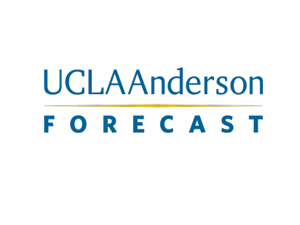December 5, 2018 - UCLA Anderson Forecast’s final quarterly report for 2018 indicates that the economy is in the process of downshifting from 3 percent growth in real GDP this year to 2  percent in 2019, and 1 percent in 2020.
percent in 2019, and 1 percent in 2020.
Recognizing that the nation and California are experiencing full employment, the forecast asserts that 3 percent quarterly growth is not sustainable. With the Federal Reserve raising interest rates, trade tensions rising, the impact of the fiscal stimulus from tax cuts and spending increases waning, financial markets will likely experience increased turbulence.
The big question in California, which has been benefiting from rapid growth in the tech industry, is how long that boom can continue.
The national forecast
In his outlook for the national economy, UCLA Anderson senior economist David Shulman writes that “growth will gradually taper off in all of the major sectors of the economy.”
While consumer spending growth has been strong, peaking at 4 percent in the second quarter, growth is expected to decrease to 2 percent by the fourth quarter of 2019 and to 1.5 percent by the fourth quarter of 2020. Housing starts will advance to 1.26 million units this year, up from 1.21 million units in 2017 with modest gains to 1.31 million expected in 2019 and 1.32 million units in 2020. This level of activity lags below the 1.4 million to 1.5 million units that would be consistent with long-run demand. In short, “housing activity remains in a rut,” Shulman writes.
The recent volatility in stock prices appears to signal an end to benign financial markets.
“Although most market pundits blame the increased volatility of Fed policy and a peak in the growth rate in corporate profits, when you look under the hood you may notice more serious risks facing the financial markets — namely, over-leveraged corporations and escalating trade tensions, especially with China,” Shulman writes. “And don’t forget that the energy, social media, banking and pharmaceutical industries will soon find themselves in the crosshairs of the newly elected Democratic House of Representatives. This looks to be a good year for Main Street and choppy year for Wall Street.”
Shulman’s essay does identify some bright spots that signal healthy economic growth. One is defense spending, which increased 3.4 percent this year and is forecast to rise by 4.9 percent in 2019 before leveling off with a 0.8 percent gain in 2020.
“The Trump defense buildup is for real,” he writes.
Intellectual property is another promising area, forecast to increase at a white-hot annual rate of 9 percent beginning this quarter. This broad category includes computer software, research and development, as well as filmed entertainment. Although growth in this sector is expected to taper off in the future, it will consistently grow faster than the economy as a whole.
The California forecast
UCLA Anderson forecast director Jerry Nickelsburg writes that the California forecasts for 2018 and 2019 have not changed much from the June 2018 outlook. He anticipates that California’s economy in 2020 will be slightly weaker, compliments of changes in fiscal policy that also will affect the national outlook.
While the state’s economy has been evolving as expected, the risk of a trade war with China remains a concern, as it could adversely affect the logistics industry, one of the fastest-growing sectors in California this past year.
Nickelsburg expects California’s average unemployment rate to have its normal differential to the U.S. rate, at 4.6 percent in 2020. Total employment is expected to grow in the mid-1 percent range in 2019 and slow to less than 1 percent in 2020. Real personal income growth is forecast to be in the upper 3 percent range in 2019 and will cool to just below 3 percent in 2020. Homebuilding will accelerate to about 140,000 units annually by the end of the forecast horizon in 2020.
All of the economists’ reports will be presented at the UCLA Anderson Forecast’s quarterly conference on Wednesday, December 5, in Korn Convocation Hall at UCLA Anderson School of Management. Visit the Anderson Forecast website for more information about attending the conference.
UCLA Anderson Forecast is one of the most widely watched and often-cited economic outlooks for California and the nation, and was unique in predicting both the seriousness of the early-1990s downturn in California and the strength of the state’s rebound since 1993. More recently, the Forecast was credited as the first major U.S. economic forecasting group to declare the recession of 2001.
Source: UCLA









